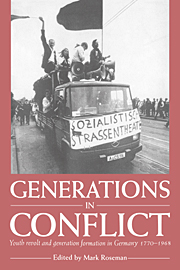Book contents
- Frontmatter
- Contents
- Contributors
- Acknowledgements
- List of abbreviations
- 1 Introduction: generation conflict and German history 1770–1968
- 2 The ideal of youth in late eighteenth-century Germany
- 3 Young Germans and Young Germany: some remarks on the history of German youth in the late eighteenth and in the first half of the nineteenth century
- 4 The battle for the young: mobilising young people in Wilhelmine Germany
- 5 Jewish politics and generational change in Wilhelmine Germany
- 6 The ‘front generation’ and the politics of Weimar Germany
- 7 The New Woman and generation conflict: perceptions of young women's sexual mores in the Weimar Republic
- 8 Generations of German historians: patronage, censorship and the containment of generation conflict 1918–1945
- 9 Gender, generation and politics: young Protestant women in the final years of the Weimar Republic
- 10 The Hitler Youth generation and its role in the two post-war German states
- 11 The BDM generation: a female generation in transition from dictatorship to democracy
- 12 A generation twice betrayed: youth policy in the transition from the Third Reich to the Soviet Zone of Occupation (1945–1946)
- 13 The generation conflict that never was: young labour in the Ruhr mining industry 1945–1957
- 14 The German Kriegskinder: origins and impact of the generation of 1968
- Index
13 - The generation conflict that never was: young labour in the Ruhr mining industry 1945–1957
Published online by Cambridge University Press: 19 October 2009
- Frontmatter
- Contents
- Contributors
- Acknowledgements
- List of abbreviations
- 1 Introduction: generation conflict and German history 1770–1968
- 2 The ideal of youth in late eighteenth-century Germany
- 3 Young Germans and Young Germany: some remarks on the history of German youth in the late eighteenth and in the first half of the nineteenth century
- 4 The battle for the young: mobilising young people in Wilhelmine Germany
- 5 Jewish politics and generational change in Wilhelmine Germany
- 6 The ‘front generation’ and the politics of Weimar Germany
- 7 The New Woman and generation conflict: perceptions of young women's sexual mores in the Weimar Republic
- 8 Generations of German historians: patronage, censorship and the containment of generation conflict 1918–1945
- 9 Gender, generation and politics: young Protestant women in the final years of the Weimar Republic
- 10 The Hitler Youth generation and its role in the two post-war German states
- 11 The BDM generation: a female generation in transition from dictatorship to democracy
- 12 A generation twice betrayed: youth policy in the transition from the Third Reich to the Soviet Zone of Occupation (1945–1946)
- 13 The generation conflict that never was: young labour in the Ruhr mining industry 1945–1957
- 14 The German Kriegskinder: origins and impact of the generation of 1968
- Index
Summary
As the war ended, surviving members of Germany's former trades union leaders set about re-establishing collective interest representation for the workers. Alongside uncertainties about future Allied policy or the employers' position, many unionists were worried about what the response of the Hitler Youth (HJ) generation would be. After all, no German aged 26 or less in 1945 could have had any experience of a trades union. Indeed, those born at the end of World War 1 and who thus entered the labour market during the slump, frequently went from unemployment to Reich Labour Service to military service to wartime call up without ever being part of a normal industrial workforce at all.Youngsters that did manage to gain some industrial experience knew only the emasculated Councils of Trust and the German Labour Front. If they managed to assert their interests in the boom conditions of the late 1930s and early 1940s they did so only on an individual, not an organised collective basis. In addition, the young generation knew nothing of Weimar's subculture of workers' political and cultural organisations, banned since 1933. Terror had made it in many cases too dangerous for parents to communicate an anti-Nazi view to their children even in private.
Particularly worrying for older labour leaders in 1945 were the many signs that the Nazis had been at least partially successful in creating out of young Germans a generation of willing followers. In the HJ, in national service and in wartime military service the Nazis drilled youngsters from all social backgrounds to accept the discipline of hierarchical organisations. At the same time, the Nazis' propaganda and social policy enjoyed considerable resonance.
- Type
- Chapter
- Information
- Generations in ConflictYouth Revolt and Generation Formation in Germany 1770–1968, pp. 269 - 289Publisher: Cambridge University PressPrint publication year: 1995



